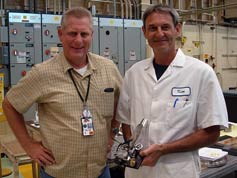
Handy Links
SLAC News Center
SLAC Today
- Subscribe
- Archives: Feb 2006-May 20, 2011
- Archives: May 23, 2011 and later
- Submit Feedback or Story Ideas
- About SLAC Today
SLAC News
Lab News
- Interactions
- Lightsources.org
- ILC NewsLine
- Int'l Science Grid This Week
- Fermilab Today
- Berkeley Lab News
- @brookhaven TODAY
- DOE Pulse
- CERN Courier
- DESY inForm
- US / LHC
SLAC Links
- Emergency
- Safety
- Policy Repository
- Site Entry Form

- Site Maps
- M & O Review
- Computing Status & Calendar
- SLAC Colloquium
- SLACspeak
- SLACspace
- SLAC Logo
- Café Menu
- Flea Market
- Web E-mail
- Marguerite Shuttle
- Discount Commuter Passes
-
Award Reporting Form
- SPIRES
- SciDoc
- Activity Groups
- Library
Stanford
Around the Bay
A Monster in the Machine
A team of SLAC engineers and machinists recently brought one small component, which may someday be a part of the Large Hadron Collider (LHC), from paper to reality. The proposed device under development at SLAC will rotate the cylindrical beam collimators that shave off unwanted portions of the proton beam. It is no bigger than a six-pack of soda and topped with a collection of precision gears. (See a related SLAC Today article here.)
"It's an intricate little monster," SLAC machinist Kim Cook said of the device. "It took a lot of teamwork to transform a 23-pound block of stainless steel into such a complicated device."
The device is a small but important piece of the proposed collimator. When the LHC is up and running, the collimator edges will occasionally be struck by errant protons and stripped of some of their surface metal. When this hopefully rare event happens, the newly built support and gear cluster will rotate the collimator to present an undamaged surface to the beam.
Depending on the actual conditions seen at the LHC, and the relative merits of the SLAC collimator as compared to other designs being developed by CERN, 72 of these "intricate little monsters" may be produced as part of Phase II collimation upgrade program of the LHC..
Creating such a complicated device for the LHC requires massive amounts of teamwork and cooperation. Through months of collaboration and communication, a team of SLAC engineers and machinists are developing the collimator prototype. The support and gear cluster is now traveling the country to demonstrate how challenges of the LHC can be solved.
"The piece operates in a vacuum, but it wasn't built in a vacuum," SLAC engineer Steve Lundgren said with a grin. "I was consulting Kim several times a week, asking how we could design the piece to make fabrication procedures easier."
In addition to Cook and Lundgren, seven other SLAC employees helped produce the part. Gene Anzalone took the concept and configured it into a manufacturable device, Eric Doyle performed stress analysis, Roland Kurz machined some of the gears and Pete Franco provided wire work. Hugh Reynolds, Rafael Huerta, and Paul Tomasi also provided carefully crafted parts for the beam collimator rotator.
"We don't just make parts," said Kim. "We create tools to help engineers and scientists succeed."
—Ken Kingery, SLAC Today, July 27, 2007
Above image: Steven Lundgren (left) and Kim Cook (right) with their "intricate little monster," a beam collimator rotator recently built by a team effort at SLAC.
